Analyzing KiKos and the South Korean Won: Finance Case Study
VerifiedAdded on 2022/10/19
|7
|1771
|171
Case Study
AI Summary
This case study analyzes the financial situation of South Korean exporters and their use of Knock-In Knock-Out (KiKo) currency options to hedge against the appreciating South Korean won. The assignment explores the expectations and fears of these exporters, the responsibilities of banks in offering and promoting derivative products, and identifies the parties at fault in the resulting financial losses. The analysis highlights the importance of understanding complex financial instruments, the need for banks to clearly communicate risks, and the lessons learned from this case for firms using foreign currency derivative products. The study emphasizes the significance of thorough knowledge, long-term planning, and transparent communication in managing currency risk, particularly the potential downsides of these financial instruments. The case highlights the need for exporters to understand the products they are using to avoid significant financial losses.
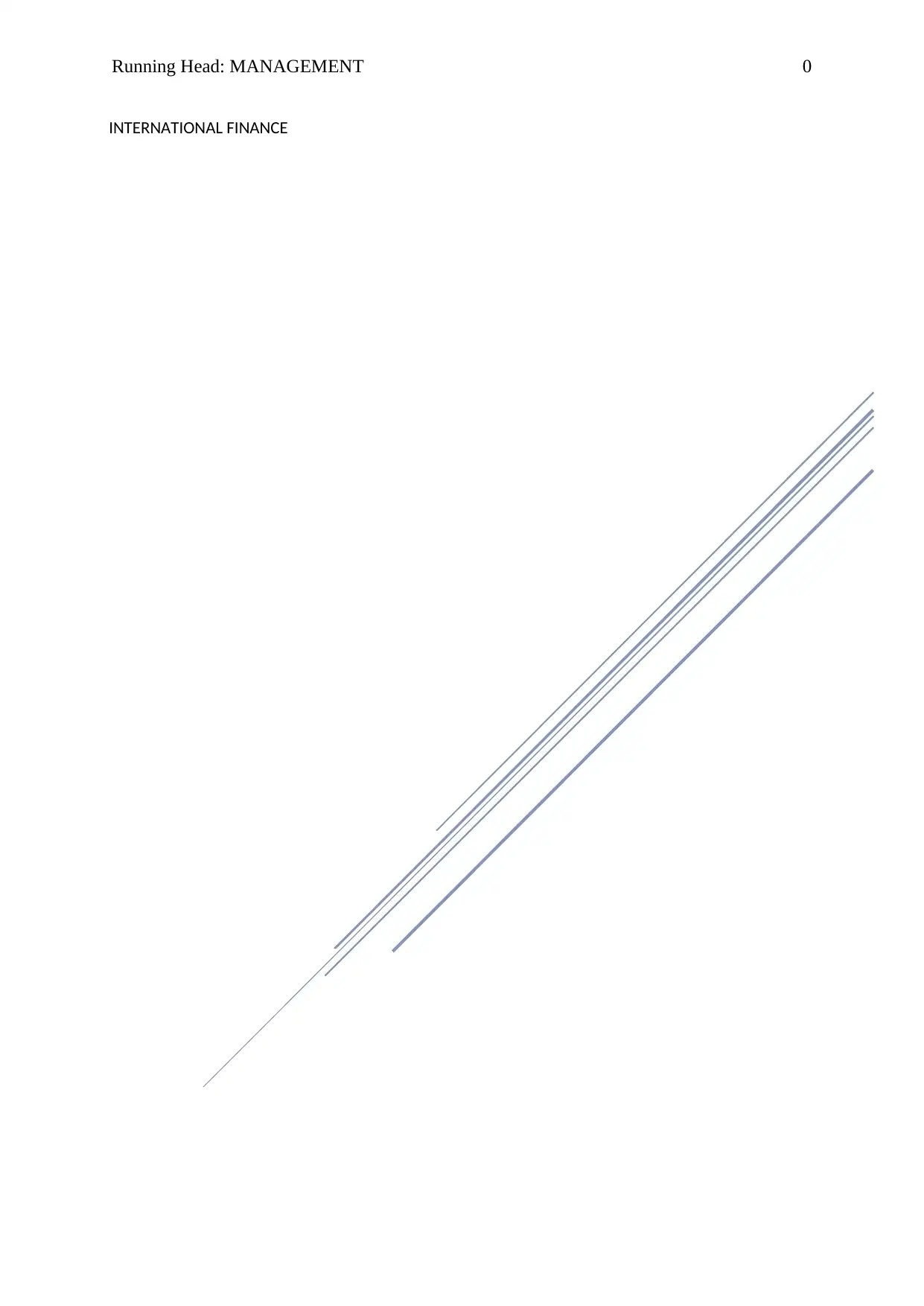
Running Head: MANAGEMENT 0
INTERNATIONAL FINANCE
INTERNATIONAL FINANCE
Paraphrase This Document
Need a fresh take? Get an instant paraphrase of this document with our AI Paraphraser
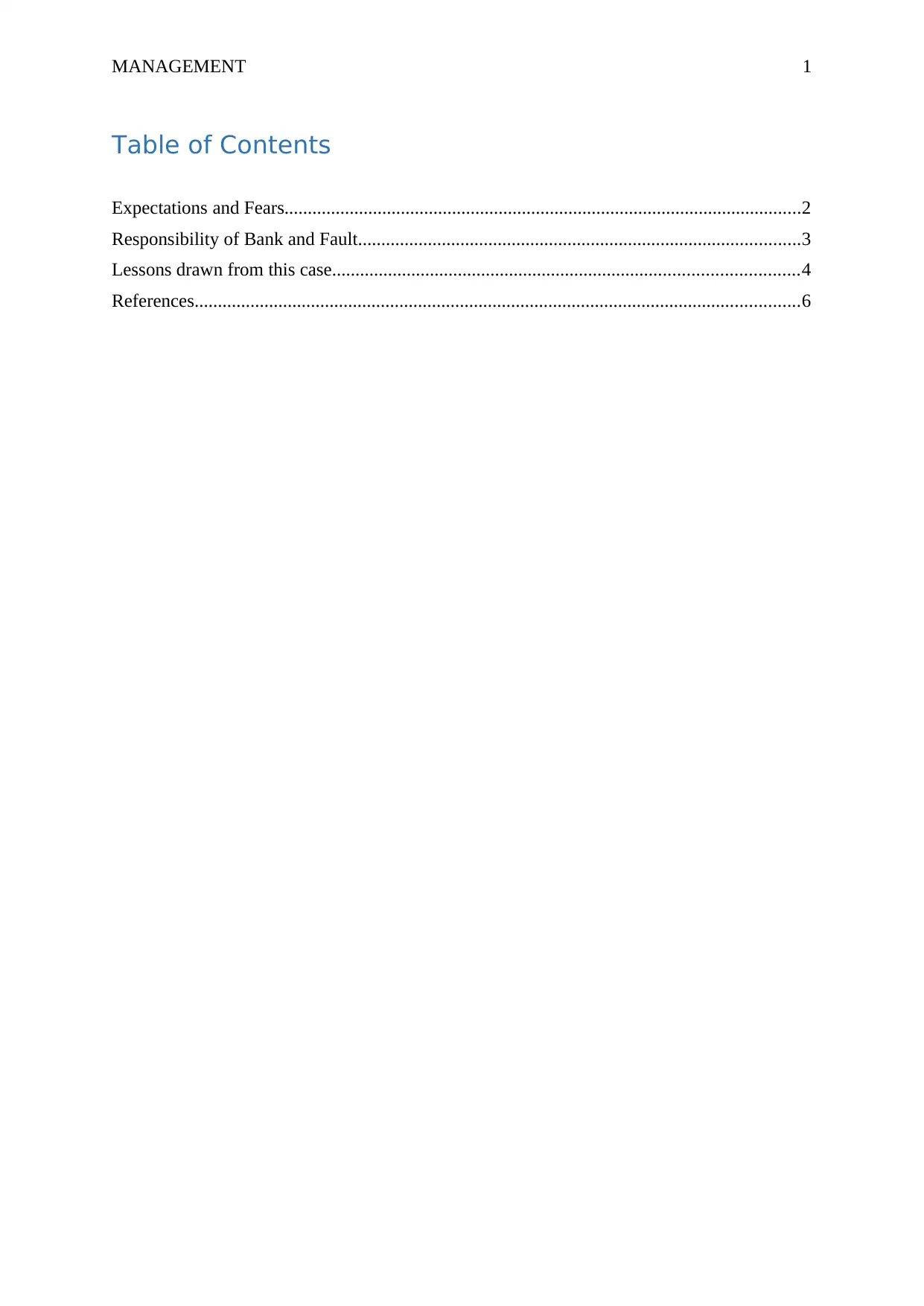
MANAGEMENT 1
Table of Contents
Expectations and Fears...............................................................................................................2
Responsibility of Bank and Fault...............................................................................................3
Lessons drawn from this case....................................................................................................4
References..................................................................................................................................6
Table of Contents
Expectations and Fears...............................................................................................................2
Responsibility of Bank and Fault...............................................................................................3
Lessons drawn from this case....................................................................................................4
References..................................................................................................................................6
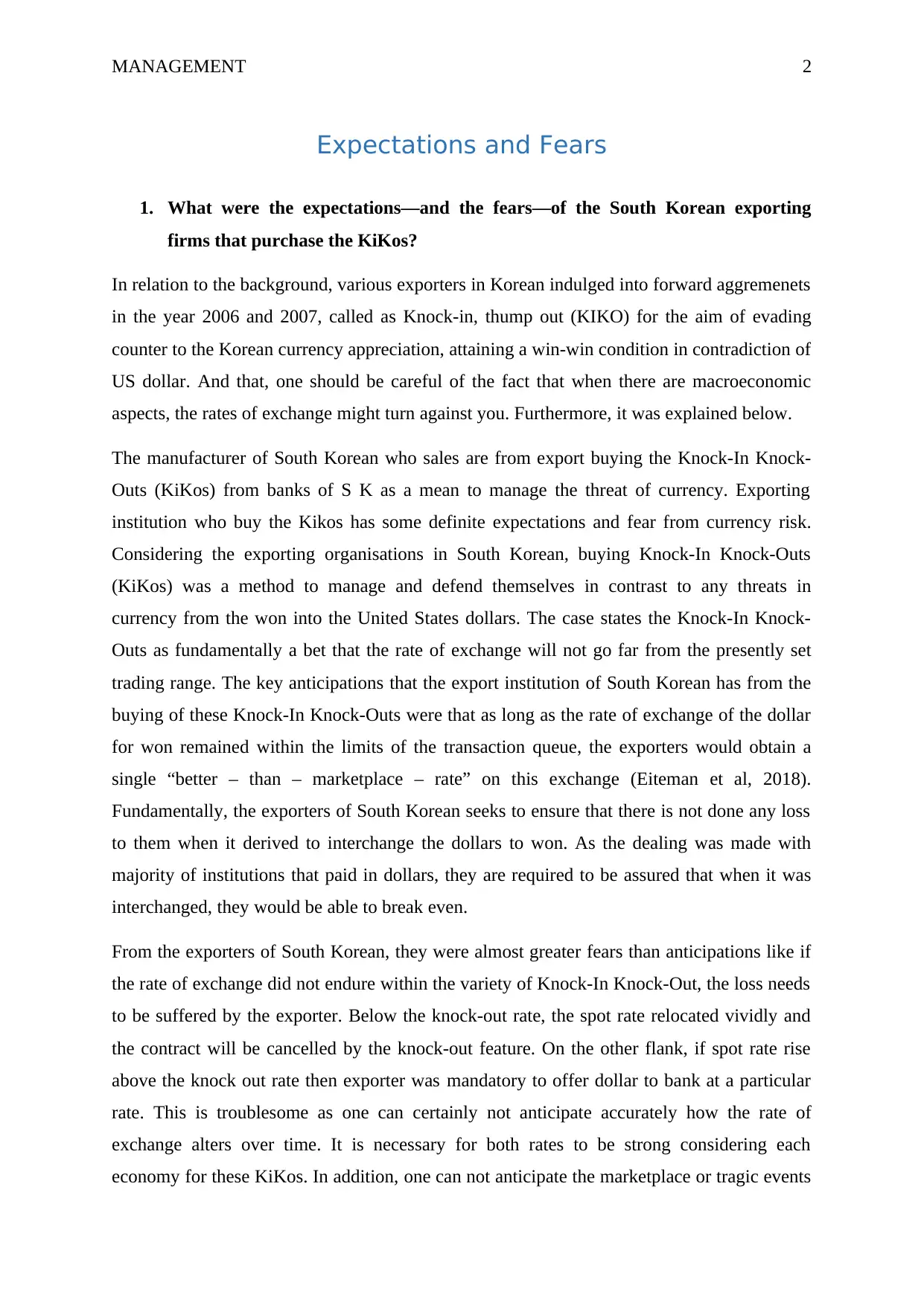
MANAGEMENT 2
Expectations and Fears
1. What were the expectations—and the fears—of the South Korean exporting
firms that purchase the KiKos?
In relation to the background, various exporters in Korean indulged into forward aggremenets
in the year 2006 and 2007, called as Knock-in, thump out (KIKO) for the aim of evading
counter to the Korean currency appreciation, attaining a win-win condition in contradiction of
US dollar. And that, one should be careful of the fact that when there are macroeconomic
aspects, the rates of exchange might turn against you. Furthermore, it was explained below.
The manufacturer of South Korean who sales are from export buying the Knock-In Knock-
Outs (KiKos) from banks of S K as a mean to manage the threat of currency. Exporting
institution who buy the Kikos has some definite expectations and fear from currency risk.
Considering the exporting organisations in South Korean, buying Knock-In Knock-Outs
(KiKos) was a method to manage and defend themselves in contrast to any threats in
currency from the won into the United States dollars. The case states the Knock-In Knock-
Outs as fundamentally a bet that the rate of exchange will not go far from the presently set
trading range. The key anticipations that the export institution of South Korean has from the
buying of these Knock-In Knock-Outs were that as long as the rate of exchange of the dollar
for won remained within the limits of the transaction queue, the exporters would obtain a
single “better – than – marketplace – rate” on this exchange (Eiteman et al, 2018).
Fundamentally, the exporters of South Korean seeks to ensure that there is not done any loss
to them when it derived to interchange the dollars to won. As the dealing was made with
majority of institutions that paid in dollars, they are required to be assured that when it was
interchanged, they would be able to break even.
From the exporters of South Korean, they were almost greater fears than anticipations like if
the rate of exchange did not endure within the variety of Knock-In Knock-Out, the loss needs
to be suffered by the exporter. Below the knock-out rate, the spot rate relocated vividly and
the contract will be cancelled by the knock-out feature. On the other flank, if spot rate rise
above the knock out rate then exporter was mandatory to offer dollar to bank at a particular
rate. This is troublesome as one can certainly not anticipate accurately how the rate of
exchange alters over time. It is necessary for both rates to be strong considering each
economy for these KiKos. In addition, one can not anticipate the marketplace or tragic events
Expectations and Fears
1. What were the expectations—and the fears—of the South Korean exporting
firms that purchase the KiKos?
In relation to the background, various exporters in Korean indulged into forward aggremenets
in the year 2006 and 2007, called as Knock-in, thump out (KIKO) for the aim of evading
counter to the Korean currency appreciation, attaining a win-win condition in contradiction of
US dollar. And that, one should be careful of the fact that when there are macroeconomic
aspects, the rates of exchange might turn against you. Furthermore, it was explained below.
The manufacturer of South Korean who sales are from export buying the Knock-In Knock-
Outs (KiKos) from banks of S K as a mean to manage the threat of currency. Exporting
institution who buy the Kikos has some definite expectations and fear from currency risk.
Considering the exporting organisations in South Korean, buying Knock-In Knock-Outs
(KiKos) was a method to manage and defend themselves in contrast to any threats in
currency from the won into the United States dollars. The case states the Knock-In Knock-
Outs as fundamentally a bet that the rate of exchange will not go far from the presently set
trading range. The key anticipations that the export institution of South Korean has from the
buying of these Knock-In Knock-Outs were that as long as the rate of exchange of the dollar
for won remained within the limits of the transaction queue, the exporters would obtain a
single “better – than – marketplace – rate” on this exchange (Eiteman et al, 2018).
Fundamentally, the exporters of South Korean seeks to ensure that there is not done any loss
to them when it derived to interchange the dollars to won. As the dealing was made with
majority of institutions that paid in dollars, they are required to be assured that when it was
interchanged, they would be able to break even.
From the exporters of South Korean, they were almost greater fears than anticipations like if
the rate of exchange did not endure within the variety of Knock-In Knock-Out, the loss needs
to be suffered by the exporter. Below the knock-out rate, the spot rate relocated vividly and
the contract will be cancelled by the knock-out feature. On the other flank, if spot rate rise
above the knock out rate then exporter was mandatory to offer dollar to bank at a particular
rate. This is troublesome as one can certainly not anticipate accurately how the rate of
exchange alters over time. It is necessary for both rates to be strong considering each
economy for these KiKos. In addition, one can not anticipate the marketplace or tragic events
⊘ This is a preview!⊘
Do you want full access?
Subscribe today to unlock all pages.

Trusted by 1+ million students worldwide
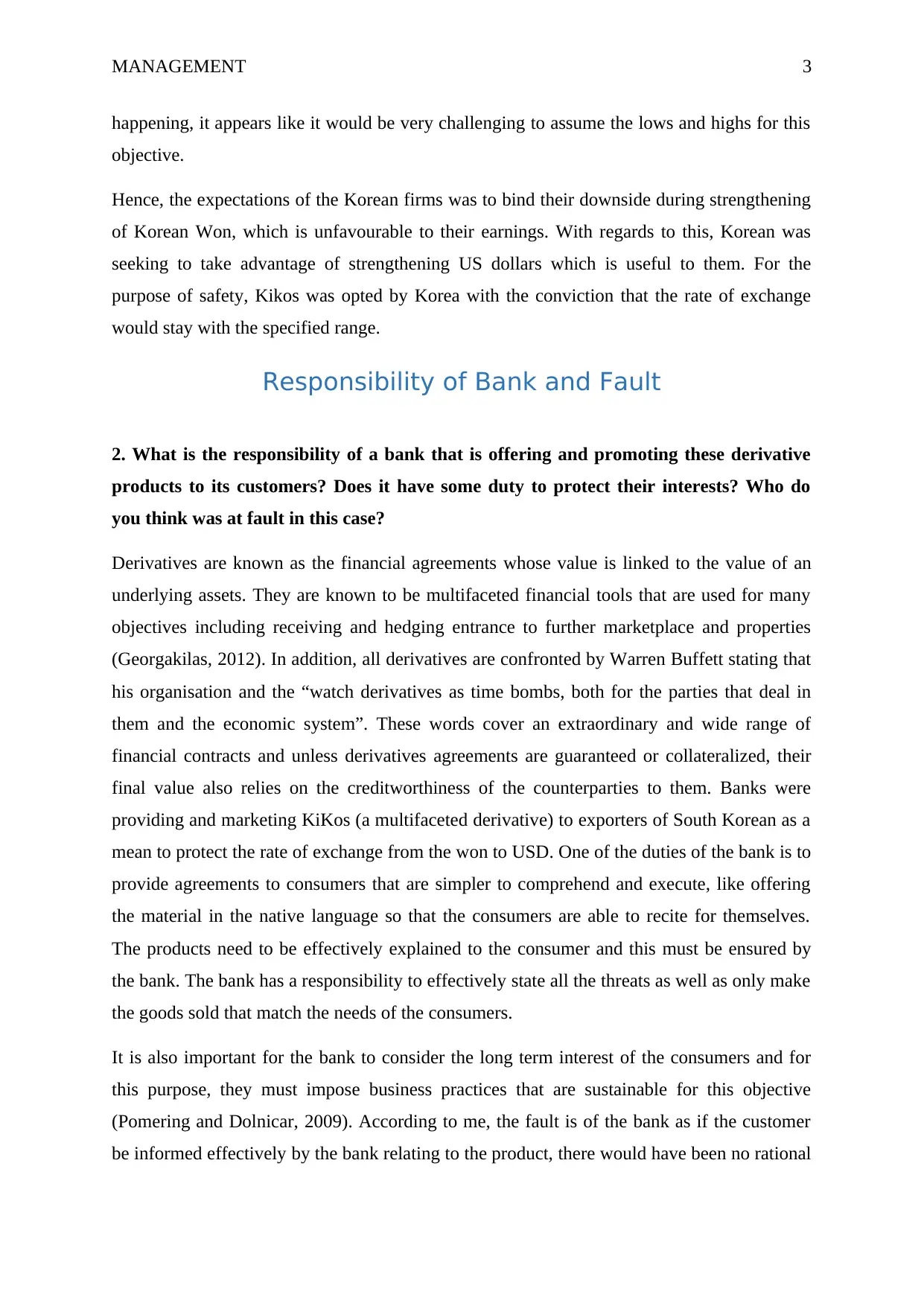
MANAGEMENT 3
happening, it appears like it would be very challenging to assume the lows and highs for this
objective.
Hence, the expectations of the Korean firms was to bind their downside during strengthening
of Korean Won, which is unfavourable to their earnings. With regards to this, Korean was
seeking to take advantage of strengthening US dollars which is useful to them. For the
purpose of safety, Kikos was opted by Korea with the conviction that the rate of exchange
would stay with the specified range.
Responsibility of Bank and Fault
2. What is the responsibility of a bank that is offering and promoting these derivative
products to its customers? Does it have some duty to protect their interests? Who do
you think was at fault in this case?
Derivatives are known as the financial agreements whose value is linked to the value of an
underlying assets. They are known to be multifaceted financial tools that are used for many
objectives including receiving and hedging entrance to further marketplace and properties
(Georgakilas, 2012). In addition, all derivatives are confronted by Warren Buffett stating that
his organisation and the “watch derivatives as time bombs, both for the parties that deal in
them and the economic system”. These words cover an extraordinary and wide range of
financial contracts and unless derivatives agreements are guaranteed or collateralized, their
final value also relies on the creditworthiness of the counterparties to them. Banks were
providing and marketing KiKos (a multifaceted derivative) to exporters of South Korean as a
mean to protect the rate of exchange from the won to USD. One of the duties of the bank is to
provide agreements to consumers that are simpler to comprehend and execute, like offering
the material in the native language so that the consumers are able to recite for themselves.
The products need to be effectively explained to the consumer and this must be ensured by
the bank. The bank has a responsibility to effectively state all the threats as well as only make
the goods sold that match the needs of the consumers.
It is also important for the bank to consider the long term interest of the consumers and for
this purpose, they must impose business practices that are sustainable for this objective
(Pomering and Dolnicar, 2009). According to me, the fault is of the bank as if the customer
be informed effectively by the bank relating to the product, there would have been no rational
happening, it appears like it would be very challenging to assume the lows and highs for this
objective.
Hence, the expectations of the Korean firms was to bind their downside during strengthening
of Korean Won, which is unfavourable to their earnings. With regards to this, Korean was
seeking to take advantage of strengthening US dollars which is useful to them. For the
purpose of safety, Kikos was opted by Korea with the conviction that the rate of exchange
would stay with the specified range.
Responsibility of Bank and Fault
2. What is the responsibility of a bank that is offering and promoting these derivative
products to its customers? Does it have some duty to protect their interests? Who do
you think was at fault in this case?
Derivatives are known as the financial agreements whose value is linked to the value of an
underlying assets. They are known to be multifaceted financial tools that are used for many
objectives including receiving and hedging entrance to further marketplace and properties
(Georgakilas, 2012). In addition, all derivatives are confronted by Warren Buffett stating that
his organisation and the “watch derivatives as time bombs, both for the parties that deal in
them and the economic system”. These words cover an extraordinary and wide range of
financial contracts and unless derivatives agreements are guaranteed or collateralized, their
final value also relies on the creditworthiness of the counterparties to them. Banks were
providing and marketing KiKos (a multifaceted derivative) to exporters of South Korean as a
mean to protect the rate of exchange from the won to USD. One of the duties of the bank is to
provide agreements to consumers that are simpler to comprehend and execute, like offering
the material in the native language so that the consumers are able to recite for themselves.
The products need to be effectively explained to the consumer and this must be ensured by
the bank. The bank has a responsibility to effectively state all the threats as well as only make
the goods sold that match the needs of the consumers.
It is also important for the bank to consider the long term interest of the consumers and for
this purpose, they must impose business practices that are sustainable for this objective
(Pomering and Dolnicar, 2009). According to me, the fault is of the bank as if the customer
be informed effectively by the bank relating to the product, there would have been no rational
Paraphrase This Document
Need a fresh take? Get an instant paraphrase of this document with our AI Paraphraser
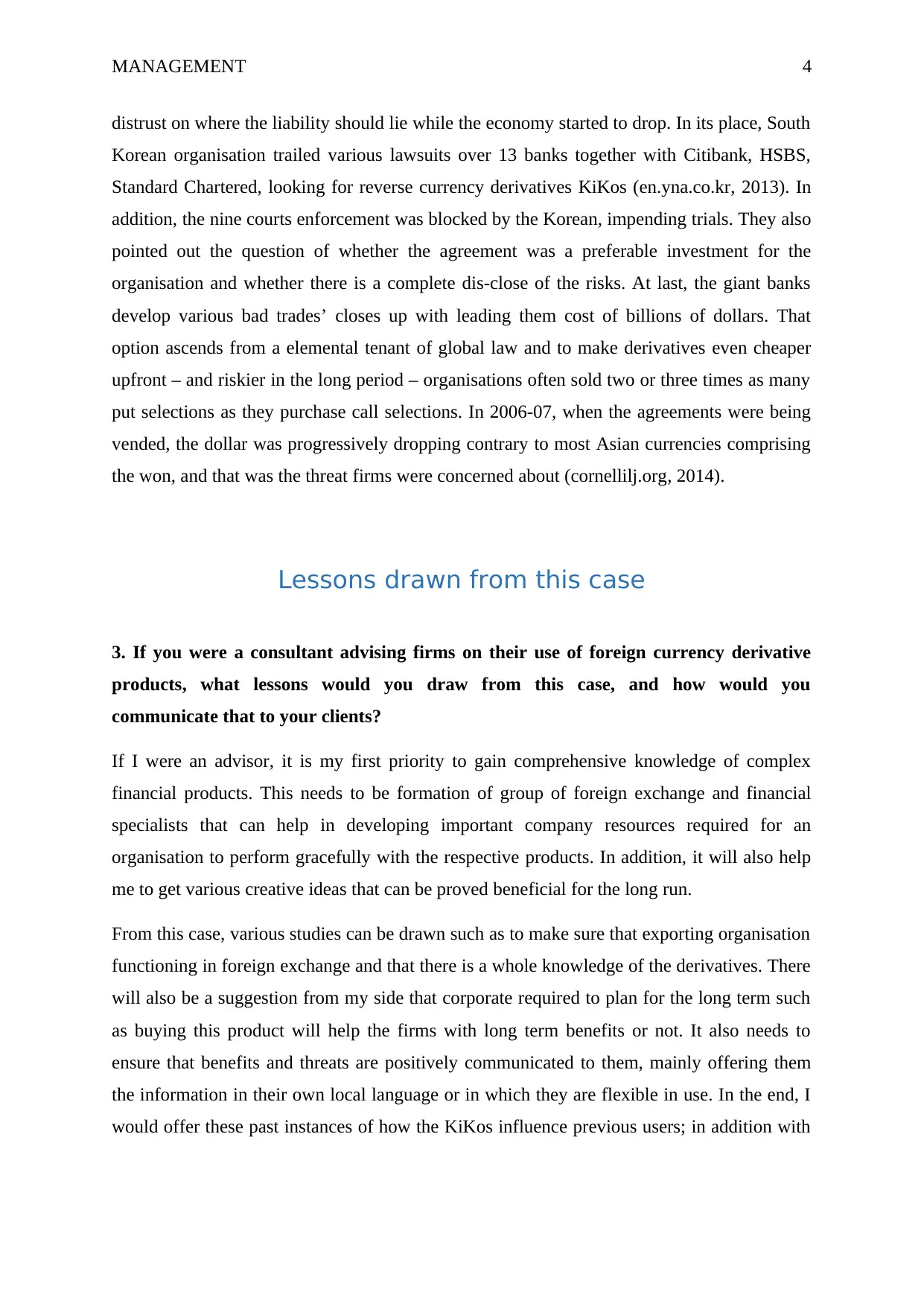
MANAGEMENT 4
distrust on where the liability should lie while the economy started to drop. In its place, South
Korean organisation trailed various lawsuits over 13 banks together with Citibank, HSBS,
Standard Chartered, looking for reverse currency derivatives KiKos (en.yna.co.kr, 2013). In
addition, the nine courts enforcement was blocked by the Korean, impending trials. They also
pointed out the question of whether the agreement was a preferable investment for the
organisation and whether there is a complete dis-close of the risks. At last, the giant banks
develop various bad trades’ closes up with leading them cost of billions of dollars. That
option ascends from a elemental tenant of global law and to make derivatives even cheaper
upfront – and riskier in the long period – organisations often sold two or three times as many
put selections as they purchase call selections. In 2006-07, when the agreements were being
vended, the dollar was progressively dropping contrary to most Asian currencies comprising
the won, and that was the threat firms were concerned about (cornellilj.org, 2014).
Lessons drawn from this case
3. If you were a consultant advising firms on their use of foreign currency derivative
products, what lessons would you draw from this case, and how would you
communicate that to your clients?
If I were an advisor, it is my first priority to gain comprehensive knowledge of complex
financial products. This needs to be formation of group of foreign exchange and financial
specialists that can help in developing important company resources required for an
organisation to perform gracefully with the respective products. In addition, it will also help
me to get various creative ideas that can be proved beneficial for the long run.
From this case, various studies can be drawn such as to make sure that exporting organisation
functioning in foreign exchange and that there is a whole knowledge of the derivatives. There
will also be a suggestion from my side that corporate required to plan for the long term such
as buying this product will help the firms with long term benefits or not. It also needs to
ensure that benefits and threats are positively communicated to them, mainly offering them
the information in their own local language or in which they are flexible in use. In the end, I
would offer these past instances of how the KiKos influence previous users; in addition with
distrust on where the liability should lie while the economy started to drop. In its place, South
Korean organisation trailed various lawsuits over 13 banks together with Citibank, HSBS,
Standard Chartered, looking for reverse currency derivatives KiKos (en.yna.co.kr, 2013). In
addition, the nine courts enforcement was blocked by the Korean, impending trials. They also
pointed out the question of whether the agreement was a preferable investment for the
organisation and whether there is a complete dis-close of the risks. At last, the giant banks
develop various bad trades’ closes up with leading them cost of billions of dollars. That
option ascends from a elemental tenant of global law and to make derivatives even cheaper
upfront – and riskier in the long period – organisations often sold two or three times as many
put selections as they purchase call selections. In 2006-07, when the agreements were being
vended, the dollar was progressively dropping contrary to most Asian currencies comprising
the won, and that was the threat firms were concerned about (cornellilj.org, 2014).
Lessons drawn from this case
3. If you were a consultant advising firms on their use of foreign currency derivative
products, what lessons would you draw from this case, and how would you
communicate that to your clients?
If I were an advisor, it is my first priority to gain comprehensive knowledge of complex
financial products. This needs to be formation of group of foreign exchange and financial
specialists that can help in developing important company resources required for an
organisation to perform gracefully with the respective products. In addition, it will also help
me to get various creative ideas that can be proved beneficial for the long run.
From this case, various studies can be drawn such as to make sure that exporting organisation
functioning in foreign exchange and that there is a whole knowledge of the derivatives. There
will also be a suggestion from my side that corporate required to plan for the long term such
as buying this product will help the firms with long term benefits or not. It also needs to
ensure that benefits and threats are positively communicated to them, mainly offering them
the information in their own local language or in which they are flexible in use. In the end, I
would offer these past instances of how the KiKos influence previous users; in addition with
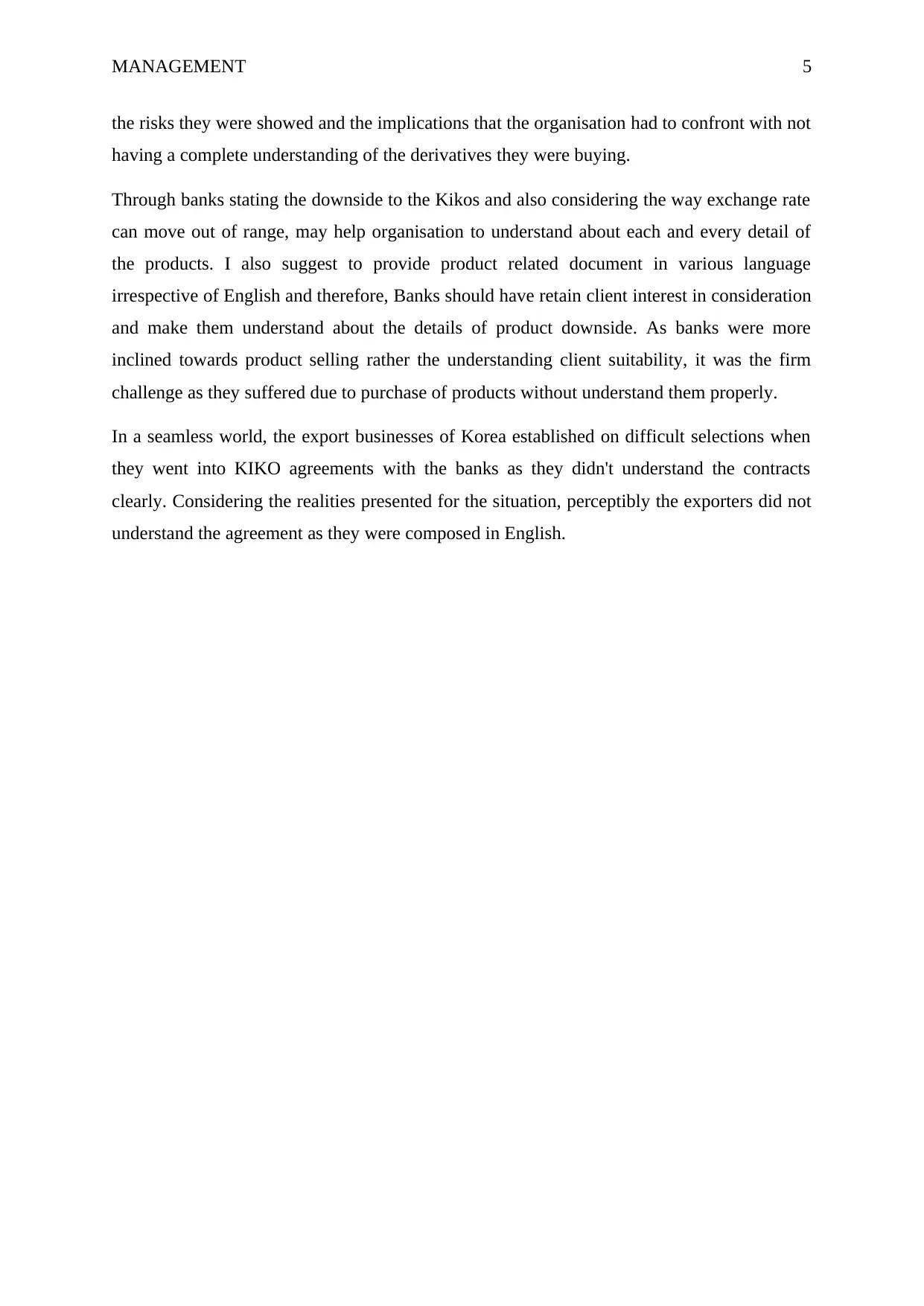
MANAGEMENT 5
the risks they were showed and the implications that the organisation had to confront with not
having a complete understanding of the derivatives they were buying.
Through banks stating the downside to the Kikos and also considering the way exchange rate
can move out of range, may help organisation to understand about each and every detail of
the products. I also suggest to provide product related document in various language
irrespective of English and therefore, Banks should have retain client interest in consideration
and make them understand about the details of product downside. As banks were more
inclined towards product selling rather the understanding client suitability, it was the firm
challenge as they suffered due to purchase of products without understand them properly.
In a seamless world, the export businesses of Korea established on difficult selections when
they went into KIKO agreements with the banks as they didn't understand the contracts
clearly. Considering the realities presented for the situation, perceptibly the exporters did not
understand the agreement as they were composed in English.
the risks they were showed and the implications that the organisation had to confront with not
having a complete understanding of the derivatives they were buying.
Through banks stating the downside to the Kikos and also considering the way exchange rate
can move out of range, may help organisation to understand about each and every detail of
the products. I also suggest to provide product related document in various language
irrespective of English and therefore, Banks should have retain client interest in consideration
and make them understand about the details of product downside. As banks were more
inclined towards product selling rather the understanding client suitability, it was the firm
challenge as they suffered due to purchase of products without understand them properly.
In a seamless world, the export businesses of Korea established on difficult selections when
they went into KIKO agreements with the banks as they didn't understand the contracts
clearly. Considering the realities presented for the situation, perceptibly the exporters did not
understand the agreement as they were composed in English.
⊘ This is a preview!⊘
Do you want full access?
Subscribe today to unlock all pages.

Trusted by 1+ million students worldwide
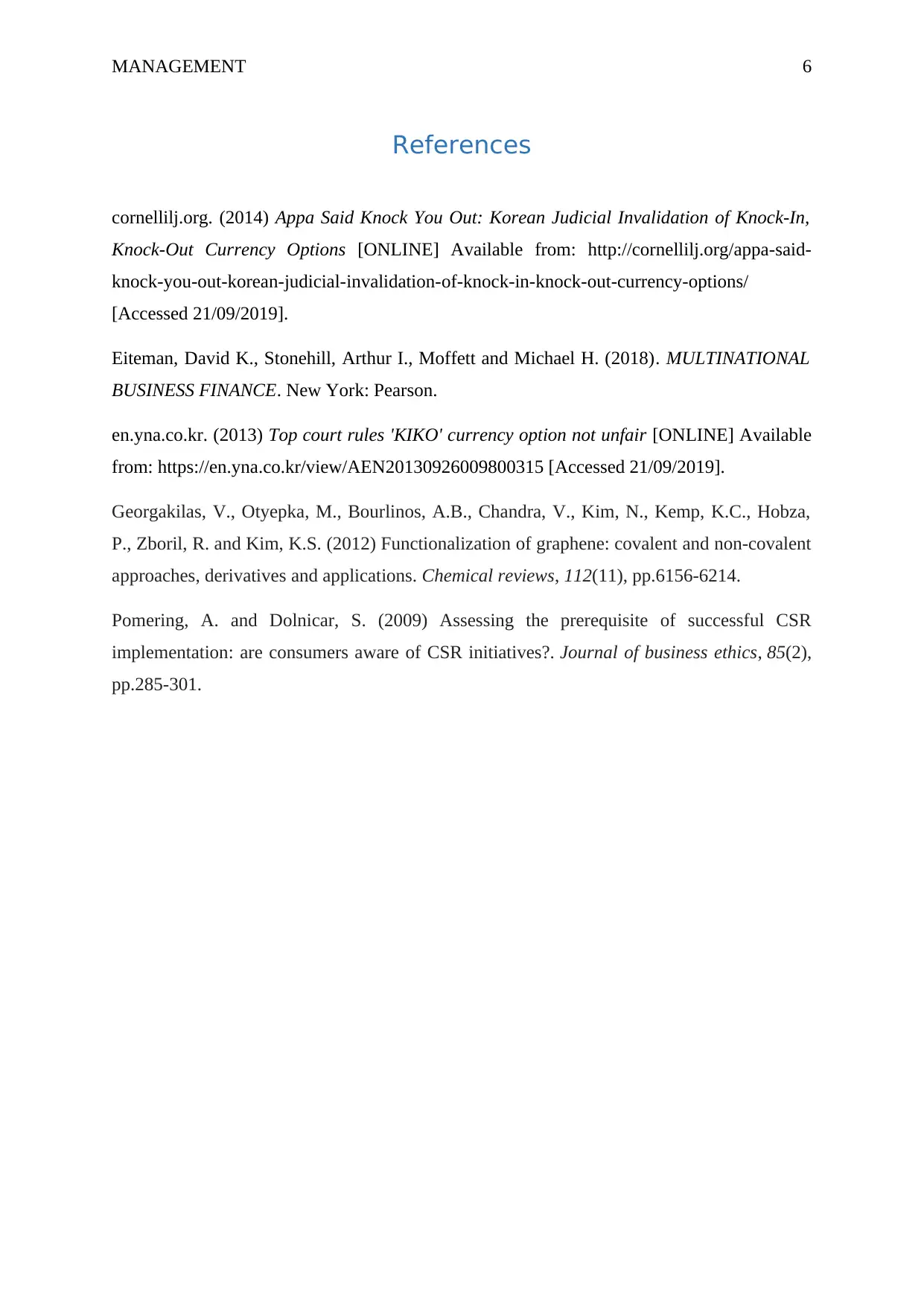
MANAGEMENT 6
References
cornellilj.org. (2014) Appa Said Knock You Out: Korean Judicial Invalidation of Knock-In,
Knock-Out Currency Options [ONLINE] Available from: http://cornellilj.org/appa-said-
knock-you-out-korean-judicial-invalidation-of-knock-in-knock-out-currency-options/
[Accessed 21/09/2019].
Eiteman, David K., Stonehill, Arthur I., Moffett and Michael H. (2018). MULTINATIONAL
BUSINESS FINANCE. New York: Pearson.
en.yna.co.kr. (2013) Top court rules 'KIKO' currency option not unfair [ONLINE] Available
from: https://en.yna.co.kr/view/AEN20130926009800315 [Accessed 21/09/2019].
Georgakilas, V., Otyepka, M., Bourlinos, A.B., Chandra, V., Kim, N., Kemp, K.C., Hobza,
P., Zboril, R. and Kim, K.S. (2012) Functionalization of graphene: covalent and non-covalent
approaches, derivatives and applications. Chemical reviews, 112(11), pp.6156-6214.
Pomering, A. and Dolnicar, S. (2009) Assessing the prerequisite of successful CSR
implementation: are consumers aware of CSR initiatives?. Journal of business ethics, 85(2),
pp.285-301.
References
cornellilj.org. (2014) Appa Said Knock You Out: Korean Judicial Invalidation of Knock-In,
Knock-Out Currency Options [ONLINE] Available from: http://cornellilj.org/appa-said-
knock-you-out-korean-judicial-invalidation-of-knock-in-knock-out-currency-options/
[Accessed 21/09/2019].
Eiteman, David K., Stonehill, Arthur I., Moffett and Michael H. (2018). MULTINATIONAL
BUSINESS FINANCE. New York: Pearson.
en.yna.co.kr. (2013) Top court rules 'KIKO' currency option not unfair [ONLINE] Available
from: https://en.yna.co.kr/view/AEN20130926009800315 [Accessed 21/09/2019].
Georgakilas, V., Otyepka, M., Bourlinos, A.B., Chandra, V., Kim, N., Kemp, K.C., Hobza,
P., Zboril, R. and Kim, K.S. (2012) Functionalization of graphene: covalent and non-covalent
approaches, derivatives and applications. Chemical reviews, 112(11), pp.6156-6214.
Pomering, A. and Dolnicar, S. (2009) Assessing the prerequisite of successful CSR
implementation: are consumers aware of CSR initiatives?. Journal of business ethics, 85(2),
pp.285-301.
1 out of 7
Your All-in-One AI-Powered Toolkit for Academic Success.
+13062052269
info@desklib.com
Available 24*7 on WhatsApp / Email
![[object Object]](/_next/static/media/star-bottom.7253800d.svg)
Unlock your academic potential
Copyright © 2020–2025 A2Z Services. All Rights Reserved. Developed and managed by ZUCOL.

